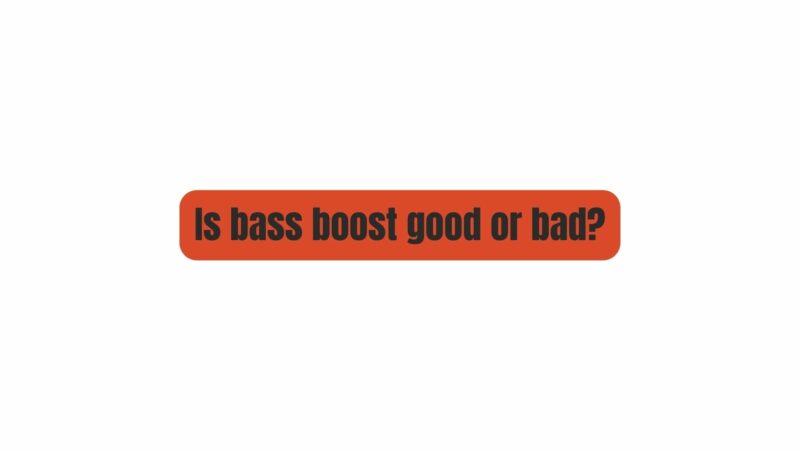In the realm of audio, the quest for the perfect sound is a never-ending journey. Audiophiles and casual listeners alike often tinker with various settings and features to achieve the audio quality they desire. One such feature that frequently enters the conversation is “bass boost.” It’s a term heard in discussions about headphones, speakers, and audio equipment. However, whether bass boost is a boon or a bane to your listening experience is a topic that divides opinions. In this article, we will delve into the nuances of bass boost, exploring its advantages, disadvantages, and the science behind it.
Understanding Bass Boost
Before we delve into the debate of whether bass boost is good or bad, let’s clarify what it actually is. Bass boost is a feature commonly found in audio equipment, including headphones, speakers, amplifiers, and even software equalizers. Its primary function is to enhance the low-frequency (bass) output of the audio. This enhancement is achieved through a variety of methods, including electronic equalization, signal processing, and the use of dedicated drivers or components.
The goal of bass boost is to make the bass frequencies in music more pronounced and impactful. This can be particularly appealing for genres like hip-hop, EDM, and dubstep, where deep and powerful bass lines are integral to the musical experience. Bass boost can make you feel the thump of the bass drum, the rumble of an explosion in a movie, or the resonance of a double bass in a classical composition.
The Pros of Bass Boost
- Enhanced Listening Experience: One of the most obvious advantages of bass boost is that it can make music and audio content more engaging. It brings depth and richness to the sound, making it feel more immersive.
- Suitable for Specific Genres: As mentioned earlier, bass boost is particularly well-suited for genres that rely heavily on bass, such as electronic and hip-hop. It can bring out the nuances in these genres that might otherwise go unnoticed.
- Customization: Many audio devices and software applications offer adjustable bass boost settings. This allows users to tailor the level of bass enhancement to their personal preferences and the type of content they are listening to.
- Compensating for Weak Bass: Some headphones and speakers have a naturally weaker bass response. Bass boost can help compensate for this deficiency, providing a more balanced listening experience.
The Cons of Bass Boost
- Potential for Distortion: One of the primary concerns with bass boost is the potential for distortion. Boosting the bass frequencies too aggressively can lead to a distorted, muddied, or “boomy” sound. This distortion is particularly noticeable at high volumes.
- Inaccurate Reproduction: Bass boost can alter the original audio signal, leading to an inaccurate representation of the intended sound. Audiophiles often prefer a more faithful reproduction of the source material.
- Compatibility Issues: Not all audio equipment handles bass boost well. Some headphones and speakers may struggle to reproduce enhanced bass accurately, leading to poor audio quality.
- Overwhelms Other Frequencies: An excessive bass boost can overpower the midrange and treble frequencies, making vocals and other elements of the music less discernible.
The Science Behind Bass Boost and Distortion
To understand the debate surrounding bass boost, it’s essential to delve into the science behind it. Bass frequencies typically range from 20 Hz to 250 Hz, and boosting these frequencies involves amplifying them. This amplification, if not carefully controlled, can lead to distortion.
- Amplification-Induced Distortion: When you boost the bass, you’re effectively increasing the power sent to the speakers or headphones in that frequency range. If the amplification exceeds the capabilities of the equipment, it can result in clipping, which is a form of distortion. Clipping occurs when the peaks of the audio signal are “clipped” off because they exceed the maximum voltage the equipment can handle.
- Inadequate Equipment: Distortion can also occur if the audio equipment is not designed to handle the boosted bass levels. Low-quality or poorly designed equipment may struggle to reproduce the enhanced bass accurately, leading to distortion.
- Equalizer Settings: Bass boost is often achieved through equalizer settings, and improper adjustment of the equalizer can lead to distortion. If the bass frequencies are boosted excessively, it can result in overloading the audio system, causing distortion.
Balancing Act: Making Bass Boost Work for You
The debate about whether bass boost is good or bad ultimately comes down to individual preferences and the equipment being used. Here are some tips to make bass boost work in your favor:
- Quality Equipment: Invest in high-quality headphones, speakers, or amplifiers that can handle bass boost without introducing distortion.
- Moderation: Use bass boost settings in moderation. Avoid excessive boosting, as it increases the risk of distortion. Experiment with different settings to find the right balance for your ears.
- Proper Equalizer Adjustment: If you’re using an equalizer to boost bass, ensure that it is properly calibrated and not pushing the frequencies to extremes.
- Choose the Right Genre: Consider the type of content you are listening to. Bass boost is most effective with bass-heavy genres, so adjust your settings accordingly.
- Listen at Moderate Volumes: Distortion is more likely to occur at high volumes. To minimize the risk, enjoy your music or audio content at moderate listening levels.
Conclusion
So, is bass boost good or bad? The answer lies in the context of your listening preferences, the quality of your equipment, and your willingness to find the right balance. Bass boost can indeed enhance your listening experience, making music more engaging and immersive, especially in genres where bass plays a crucial role.
However, it’s important to use bass boost judiciously to avoid the pitfalls of distortion and inaccurate audio reproduction. Experiment with different settings, invest in quality equipment, and be mindful of the type of content you are enjoying. Ultimately, the decision to embrace or eschew bass boost depends on your personal taste and how you want to tailor your audio experience to your ears.


